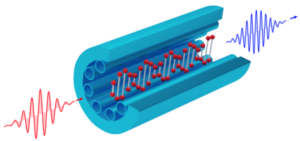
PRESS RELEASE — Quanta of light – photons – form the basis of quantum key distribution in modern cryptographic networks. Before the huge potential of quantum technology is fully realized, however, several challenges remain. A solution to one of these has now been found, according to a release from the Max Planck Institute for the Science of Light.
In a paper published in the journal Science, teams led by David Novoa, Nicolas Joly and Philip Russell report an advance in frequency up-conversion of single photons, based on a hollow-core photonic crystal fibre (PCF) filled with hydrogen gas.
First a spatio-temporal hologram of molecular vibrations is created in the gas by stimulated Raman scattering. This hologram is then used for highly efficient, correlation-preserving frequency conversion of single photons.
The system operates at a pressure-tuneable wavelength, making it potentially interesting for quantum communications, where efficient sources of indistinguishable single-photons are unavailable at wavelengths compatible with existing fibre networks. The approach combines quantum optics, gas-based nonlinear optics, hollow-core PCF, and the physics of molecular vibrations to form an efficient tool that can operate in any spectral band from the ultraviolet to the mid-infrared – an ultra-broad working range inaccessible to existing technologies.

The findings may be used to develop fibre-based tools in technologies such as quantum communications, and quantum-enhanced imaging.
If you found this article to be informative, you can explore more current quantum news here, exclusives, interviews, and podcasts.

















